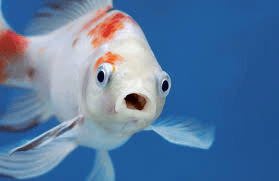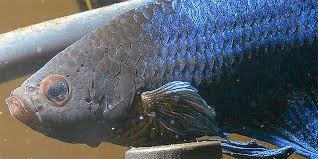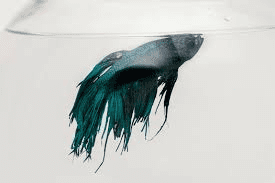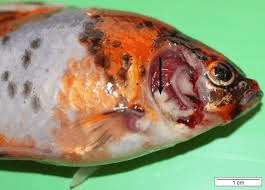It is possible for your fish not to have any disease. However, this is only possible if you take every precaution at preventing fish diseases which include adequate and proper feeding, good water maintenance and prevention of stressful conditions.
Like humans and other animals, fish suffer from diseases and parasites. Fish defences against disease are specific and non-specific. Non-specific defences include skin and scales, as well as the mucus layer secreted by the epidermis that traps microorganisms and inhibits their growth.
If pathogens breach these defences, fish can develop inflammatory responses that increase the flow of blood to infected areas and deliver white blood cells that attempt to destroy the pathogens.
Specific defences are specialised responses to particular pathogens recognised by the fish’s body, that is adaptative immune responses. In recent years, vaccines have become widely used in aquaculture and ornamental fish, for example vaccines for furunculosis in farmed salmon and koi herpes virus in koi.
All these are based on the assumption that your fishes either fingerlings or juveniles are gotten from a very good source where possible diseases from the hatchery have been eliminated. So it is possible for your fish not to be sick at all but adequate attention must be given to them in order to ensure that.
How to know when your fishes are sick

Like any other animal, it is not difficult to know when fish are sick. The signs you will observe include the following: loss of interest in feeds and feeding, the fish will begin to loose weight, some may rub their body against the wall of the pond which will result to their skin peeling off, and some of the fish may show erratic movement in the pond and may attempt jumping out of the pond.
There could be sudden change in the body coloration of the fish. The last stage is high mortality in the pond. All these are signs that should make a farmer suspect disease on his farm.
Read Also: How to manage waste from a fish farm to avoid causing nuisance to the neighborhood
Possible things that can introduce disease to your fishes
Things that can introduce diseases to your fish are many which include: their feed, water and the way they are handled by the attendants. Generally, disease-causing organisms (virus, bacteria, fungi etc) ate the ones that will cause the disease.
Feeds, water and other means will just act as the carrier of these organisms. So always watch the feed, water and the way your attendants handle the fish and the pond so that diseases are not introduced to your farm.
To know whether the disease affecting your fish is from hatchery or from your farm, so many things must be considered. At first be sure that your pond and the source of your water is very good and you then experience mortality in the first one week of life, you may suspect hatchery problem. This is after you have eliminated stress due to transportation or stocking.
Now, if mortality starts occurring after a week of life, I will advice that you critically observe all the activities on your farm for it is likely that the problem is from your farm. It may be due to stress, the kind of feed you are giving them, the water in the pond etc.
As for the symptoms of the fish, they can begin to show signs of ill-health as from any stage even as from Day Old so before venturing into fish farming, it is advisable that you have enough knowledge of the diseases that can affect them including the age at which they could be affected and what you will do if the problems occur. Always consult an expert for details on this.
Read Also: The Possible Market Outlet for Table Fishes
Prevention and Therapy of Fish Diseases
The ways of prevention and contingently of medical treatment of fish are very specific and often different from those in warm-blooded animals. They require a thorough knowledge of the environment of fish.
Preventive arrangements are consisting of complicated set of treatments elaborated on the base of a good knowledge of the aetiology of disease and a host (fish) biology.
It concerns the elimination or restriction of infection (invasion) sources and the possibilities of its further expansion likewise the enhancement of condition of fish organism in the way to be able to withstand the infection (invasion).
The prevention is of basic importance in diseases elimination. No specific therapeutics were developed for a number of diseases up to now and the result of the application of effective, experimentally verified medicaments, is often reversely affected by the operational conditions and/or the technology of rearing.
The medical treatment becames economically unrenumerative in this way. In addition, some treatments cannot be performed in certain periods, e.g. in growing season, during the wintering, or in some fish culture units (e.g. large ponds).
That is why it is much more important to prevent from the diseases than to recover them. The effective preventive treatments are to be applied above all in specialized fish culture units with closed warm water system, in early fish fry rearing, hatcheries, trout farms, wintering ponds and storage reservoirs.
Read Also: 25 Uses of Fish and Fish Products (Updated)
Generally accepted and effective principles are as follows:
a) Providing water sources free of pathogens
Underground waters are the most suitable water sources free of pathogens. These sources are limited both for trout farms and hatcheries and for other special fish culture units at present.
The surface water from rivers and channels is used as the source of inflow water in most cases. In these situations, suitable filters can partially reduce the numbers of invasion stages of parasites in inflow water, above all when supplying smaller reservoirs with intensive culture.
Bars are usually placed before these filters to separate rough particles. Sand filters are consisted of a set of sedimentation divisions terminated by filter with fibre and sand.
These type of filters catch above all the heavier parasite stages unable to move actively (e.g. spores). Lower efficiency is registered in elimination of moving parasites like e.g. infusorians.
The water from the pond with fish stock is quite unsuitable for these purposes (esp. as the source of inflow water for trout farms, hatcheries and units for early fish fry stages).
Chemical treatment of inflow water is an emergency arrangement with often undesirable parallel affects. Disinfection of the water entering fish culture units by UV radiation is not still an usual way although it can be considered as the simple method how to destroy viruses, bacteria and moulds germs.
Since the inflow water from rivers and channels is slightly turbid and contents a number of suspended solids and dissolved compounds, the disinfective efficiency of UV radiation is markedly reduced in these situations.
It is very profitable to supply the individual ponds and/or reservoirs independently, not throughflowly. The water from each pond or reservoir should be drained separately and should not flow into any other. Especially quarantine ponds and other reservoirs can be separated by this way.
Read Also: How to Market your Matured Fishes for Profit
b) Protection from the transfer of pathogens

This principle means above all the transfer of pathogens by uncontrolled transport of fish and spawns. The transport of fish with unknown health condition is to be avoided in principle.
All transported fish are to be accompanied by veterinary certificate confirming that fish were examined before transporting them, they are healthy and originate from the environment in which no important transfer diseases appear.
The list of these diseases is precisely stated in veterinary instructions. Except of the internal survey for each country also the list of diseases stated in international codex is obligatory for veterinary service.
This list is currently specified with the development of diagnostic methods and improvement of knowledge about individual fish diseases. Some viral and bacterial diseases can be transfered also by spawns. Their transport must be completed by the same veterinary certificate like fish transport from this reason.
Fish introduced from other territories must be subjected to quarantine for one year regardless if native or extraneous species. The duration of quarantine can be prolongated e.g. in the case of fish imported from abroad until the period of 3 years.
Prolongated period of quarantine is of special importance especially in spawners predestined for further reproduction of imported species.
The selfsustaining in stock production in individual farms and similar organizations is a significant way of prevention from dissemination of fish diseases.
Only fish previously examined, free of diseases and relevantly treated by medicinal baths are to be stocked into ponds and fish culture units. The stocking of fry originating from semi-artificial and artificial spawning not contacted with fish of higher age categories also minimizes the danger of infection.
The prevention from introduction of coarse fish into ponds and fish culture units is the other important arrangement protecting the stock against transfer of pathogens.
These fish are above all the source of ectoparasites, dangerous especially in the period of decreased resistence of fish. Except of this they can transfer also some other pathogens which can result in heavy losses in important fish species. Adequate bars and filters can serve for prevention from coarse fish penetration.
The protection of piscivorous birds to step into fish culture units (esp. trout farms) is the prevention limiting the expansion of some fish diseases. Protective nets are used to prevent the birds from running in. The numbers of piscivorous birds are regulated in localities where overpopulated.
Preventive control of snails (Lymnaea sp.) as intermediate hosts of some fish parasites can be performed by biological (introduction of black carp – Myelopharyngodon piceus or 3-years-old tench Tinca tinca), mechanical (placing nets in the inflow), physical (drying and freezing of the bottom) and chemical (application of molluscocides) ways.
Safe and harmless removing of dead fish is a significant way how to prevent from further transfer of fish pathogens. Fresh or slightly decayed dead fish are decontaminated in the nearest veterinary facility.
Lower masses of dead fish are to be burnt or burried into deep pits (aprox. 2 m) in distance of at least 20 m from the pond bank. The bottom of this pit and dead fish must be covered by burnt or chlorinated lime. The layer of at least 60 – 80 cm of the soil must cover the content of a pit.
Read Also: Factors to Consider Before Starting a Fish Farming Business
c) Disinfection of ponds, fish culture units and equipment; winter freezing and summer drying of ponds

Disinfection is of a big importance in prevention and elimination of fish diseases. Preventive disinfection protects the fish stocks against pathogens. Hygiene of environmental conditions for fish is improved by this way. Focal disinfection is performed for control of the focus of dangerous fish disease.
Natural physical phenomena are fully used for disinfection in intensive fish culture due to their ecomical convenience. It concerns the drying and freezing of the pond bottom.
The most of pathogens die after perfect drying of the pond bottom when its relative moisture had dropped on 10 – 15 %. The perfect freezing of the wet places and sun radiation (above all by its UV rays) have a very favourable effect in our conditions.
The influence of these natural physical phenomena is exploited by summer drying and winter freezing of water reservoirs (ponds). Summer drying is a radical, long-term intervention during which all pathogens are controlled due to the perfect drying of the pond bottom.
The aim of winter drying is to destroy the pathogens by freeze. It safely leads to destruction of leeches (Piscicola geometra), fish lice (Argulus sp.), predatory larvae of water insects, eggs and spores of parasites and also other pathogens. Employing the natural ways for disinfection has an disadvantage in usually long-term duration (a number of months up to one year).
Chemical disinfection is an effective way of prevention from and/or suppressing of fish diseases. Usually accessible disinfective preparations are used in fish culture (e.g. burnt lime, chlorinated lime, nitrogen lime, natrium hydroxide, potassium permanganate, formaldehyde, Chloramine, Chlorseptol, Jodonal etc.).
Burnt lime is mostly employed for disinfection of the bottom of ponds and reservoirs in the dose of 2.5 – 3 t.ha-1, or chlorinated lime in the dose of 0.5 – 0.6 t.ha-1. In case of myxosporoses, nitrogen lime (5 t.ha-1, or 0.5 kg.m-2) is to be applied.
Immediately after fishing out the pond, the disinfection of fishing pit, pond ditches and muddy wet places is performed on large ponds where the whole-surface bottom disinfection is not possible.
5% water solution of formaldehyde, chlorinated lime (200 – 400 mg.1-1), 0.5 % water solution of natrium hydroxide, Chloramine and chlorseptol (30 g.1-1) or other disinfectants can be used for treatment of concrete channels, troughs and other arrangements employed for fish culture.
The same disinfectants and concentrations are to be used for the treatment of the equipment. Potassium permanganate (5 g.l-1), Jodonal (2.8 – 4.5 ml.l-1) and other disinfectants can be also employed for these purposes.
Read Also: 11 Foods and Drinks that will make you Focus
d) Optimalization of environmental conditions
The optimalization of natural environmental conditions is the main pre-condition how to ensure the good health condition of stock during the rearing period. The following principles must be ensured:
- Optimal water quality without stressing physico-chemical effects. Keeping the oxygen concentration on optimal level and protection against water pollution are of special importance,
- Maximum development of natural food resources by the adequate interventions, feeding fish by supplementary feed mixtures in sufficient amount and quality (the attention should be paid on the quality of individual feed components and biofactors), basic preventive arrangements protecting the early developmental stages and young fish from bacteria and protozoans, including sufficient amount of natural food of appropriate size and species composition,
- Responsible establishment of maximum stocking density. Inadequately high stocking density results in stress behavior, worsened condition and resistance, and makes the expansion of diseases easier. The stocking density is of special importance in trout farming and fish culture in special intensive units (but also in ponds),
- prevention from stress situations evoked by other factors, above all manipulation during fishing out, transport and long-term storage.
e) Regular control of health condition and preventive treatment of fish
Preventive control of health condition is to be carried out in hatcheries and early fry rearing units twice a week, and in highly productive intensificated ponds, trout farms and fish culture units with recycling warmed water weekly. Other stocks (esp. in usual pond culture) are investigated monthly.
Health condition of fish is always to be controlled before fishing out, transporting fish and stocking. Preventive treatment can be suggested on the base of investigational results. This treatment is performed above all by the application of medicaments into the water environment and feeding by medicated feeds.
Read Also: Factors to Consider when Selecting your Fish Farming Site
Frequently Asked Questions
We will update this section soon.

